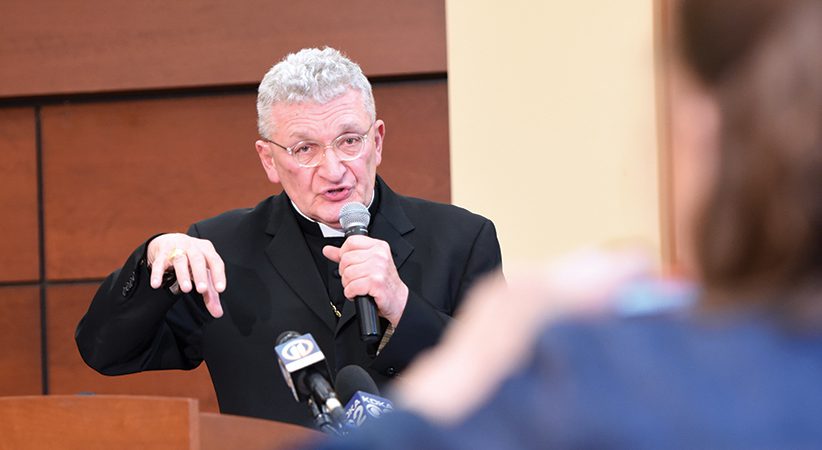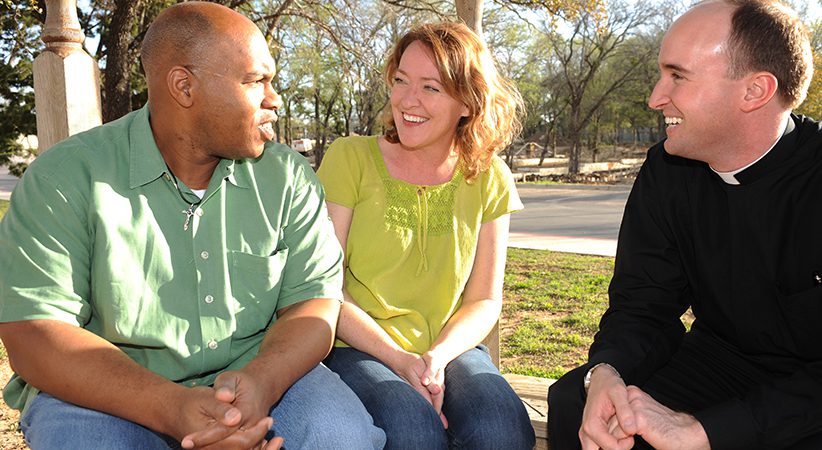Purgation, Illumination and Union
The threefold path to human and Christian maturity priests strive to follow
Susan Muto Comments Off on Purgation, Illumination and Union
From its earliest teachings to those of the present day, Christianity has promoted and emphasized a spiritual journey involving the transformation of body, mind and spirit in the pursuit of holiness and conformity to Christ. Such a pursuit has been elucidated as a threefold path, involving the dynamics of purgation, illumination and union.
Purgation refers to the intentional cleansing of one’s spirit, heart, mind and will from the deformation caused by disobedience to the Father’s will. It leads to compunction or sorrow for sin accompanied by the joy of having been redeemed and forgiven by the saving grace of our Lord, Jesus Christ.
Illumination is, in effect, a response to the enlightening grace of one’s being open to God’s grace with renewed intensity. At every moment of their life, this grace draws priests nearer to the purity of heart intended for them by God. They see their whole life in a new light; they listen every day with awe and adoration to the universal call to holiness shared by all of God’s people.
Union means a mystical identification with Christ that goes so deep that priests may find themselves saying, “Yet I live, no longer I, but Christ lives in me” (Gal 2:20). Union leads to loving communion with God, self and neighbor, resulting in the grace of intimacy with the mystery of the Holy Trinity.
The frequency and intensity of the dynamics of the threefold path vary from priest to priest. For some, the stages of purgation, illumination and union are sharply delineated, while for others they are more diffuse. Yet it is helpful to appreciate that all of these dynamics of transformation point to ongoing growth in faith, hope and love.
Ebb and Flow
The movements from purgation, through illumination, to union also tend to ebb and flow. They are never a once-and-for-all set of experiences. Thus priests can appreciate the circular, or spiraling, nature of spiritual formation and the cycles of deepening that flow together in a layered and interweaving fashion.
A priest’s journey to God encompasses, in other words, both linear and circular movements, all of which point toward his being made one with God through the power of the Holy Spirit.
The purgative path invites priests to appraise the true meaning of their trials, challenges and calls to conversion — that is to say, from deformation by sin, through the graces of purgation, to both reformation and transformation of his life as a whole.
Throughout any given day, priests are given the opportunity to cooperate with God’s grace in the purifying formation of these lingering remnants of egocentric willfulness. Pinpricks of purification may be as nondescript as an occasional bout of sleeplessness, a temporary interruption of food or drink, the annoyance of a traffic jam or a delayed flight at the airport. Such experiences afford priests the chance to die to self and open their hearts to receive still deeper graces of ongoing conversion.
Thanks to the healing power of purifying formation, priests are faced with an important question: As they recognize lingering fault lines in their human and Christian character, are they able to submit these pockets of deformation to the graces of reformation and transformation? How, in truth, did they become part of their character in the first place? How can they become more open and less resistant to the divine union for which they are destined by the grace of their vocation?
Such questions lead us to a deeper probing of the nature of what Father Adrian van Kaam, CSSp, Ph.D. (1920-2007), terms “coercive dispositions.” These are the depreciative, dissonant patterns of embedded directives and behaviors that take root in one’s heart and block, among other things, a priest’s path to appreciative living and transcendent joy. Such coercions may even take root in their physicality and become part of their so-called second nature. That is why true metanoia involves not merely an act of the will but a lifelong process of patient re-wiring and reconfiguring of the pathways carved in one’s character by deformative dispositions.
Van Kaam emphasizes that most of the time one is unaware of the dynamics inherent in one’s flawed character dispositions. As a result, priests may tend to underestimate their power. Although such deformative dispositions may be relatively available to one’s awareness, they are more often lodged and hidden in bundles of powerful, routinized behaviors and responses that have become hardwired in one’s vocation over a long period of time.
Four Counsels
As such, priests may blindly follow the deformed life directives impinging upon them due to coercive dispositions, despite the fact that they block, among other things, the priestly path to reformation and transformation of one’s human and Christian character. By submitting themselves to the workings of grace, priests can liberate their spirit, heart, mind and will from these dispositions, not by denouncing them as mere limits, but by changing them into blessings that can purify and illumine their prayer life and their service to the Church. Father van Kaam offers the following four counsels to aid the emergence of the dynamics of purifying formation, leading to the reformation of one’s Christian character and personhood:
— To increase the awareness of their own character flaws, priests need to be attentive to any regularly recurring tendency to betray fidelity to their priestly vocation.
— Priests also have to be mindful of the emotional reactions that usually accompany these out-of-character behaviors and actions. Recurrent experiences of feeling guilty or reluctant to admit faults mean that they need to look into the dispositions that are at the root of such unpriestly responses.
— Priests need to practice being calm and cultivating inner peace in order to distance themselves from the volatile emotions such actions may unleash. Only when they are inwardly silent and detached can priests explore directly and objectively dissonant dispositions that have too great an influence on their everyday life.
— Priests need to strive daily to die to the character flaws that decrease their consciousness of who they most deeply are in the mind and heart of God. Grace invites them to relinquish anything in their character that blocks receptivity to the grace of illuminating reformation, especially the dissonance that involves their memory, imagination and anticipation.
The reformation of coercive dispositions requires more time, prayer and patience than one may think. Attunement to God’s grace bears fruit in practice, but not overnight. What has piloted priests routinely, perhaps for years, cannot be altered in a flash. They need to undergo the “radical surgery” the Spirit initiates to bring to the fore the depth of conversion God alone can set in motion.
As they ponder the Christ-initiated decisions and actions that move them from the purgative way to the enlightened path of renewal of their past, present and future, priests may see the wisdom of living in trusting surrender to God and ridding their souls of remnants of willful control. By admitting their own weaknesses, they come to understand the stranglehold that such dynamics exercise upon their best intentions. Furthermore, they realize to what degree these sinful patterns may become ingrained in their hearts rather than becoming invitations to ongoing reconciliation.
The illuminative way entails a zealous commitment to growing in Christian virtue. Invisible to the eyes of the world, but visible to the eyes of faith, are the threads of Gospel truth being woven by the Lord into the fabric of every priest’s ministerial life. As their whole priestly personhood continues to be recrafted by the grace of God, their witness to Christ becomes increasingly illumined and oriented toward the three lifelines of priestly service: faith, hope and love.
Reconciliation
Their presence to the People of God in confession offers priests a constant reminder of how deep and pervasive the roots of dissonant dispositions can be. Sins thought to be past history rise again, revealing that habitual vices thought to be overcome were only truncated for a while. Yet, thanks to the light of illumination, souls may be blessed with the grace of ongoing growth in wholeness and consonance with Christ. The nearer priests themselves come to the purity of heart intended for us by the Lord, the more they know, as did the apostles of old, that they still have many things to tell us. With each passing day, they renew the resolve to pray for the courage and candor to realign their heart with the heart of their Redeemer.
To detect the pockets of resistance to grace to which disciples may still cling, priests must also return as often as possible to the practices of such essential spiritual disciplines as silence and contemplative prayer. Silence gives them the courage to detect in themselves what must be submitted to God’s reforming grace. It exhorts them to go about their apostolic life as quietly as possible; it both enhances effectiveness and fosters growth in holiness. In their practice of contemplative prayer, priests experience an abiding presence of the Lord that readies them to receive new lights and insights they can communicate in teaching and preaching.
Especially during their celebration of the Eucharist, priests make room in their hearts for the indwelling presence of the Lord that enables them to abide in the illuminating light of reformation over a lifetime. The mystical meaning of identification with the Cross begins to invade their consciousness with words of truth that move from their lips through their mind and into their heart.
Joy and Peace
The hallmark of unifying transformation that then declares itself to them is the disposition of joy. Joy is the radiant consequence of an inner gift that generates and nourishes in priests a deeper sense of the ultimate goodness of life, even in the midst of suffering. Joy does not exclude sickness, pain, disappointment or failure. It is rather like the depth of the ocean, which remains still and unperturbed even when stormy winds lash the surface of the sea.
By the same token, Christian joy and the peace that accompanies it promotes receptivity to the transforming grace of God, even when he asks his priests to carry the cross of suffering. This transcendent gift is a consequence of their growing oneness with Father, Son and Holy Spirit; it is the result of their union with their crucified and risen Lord. He is their salvation! He is their joy! No earthly wealth or power can match this pristine experience that alone can fulfill their inmost longing.
The practice of this kind of joy is more a labor of love than a strained effort. It is easy to lose joy amid the distractions of busy days, but vigilance of heart readies priests to receive and preserve this gift. They believe that the mystery of transforming love reveals itself in the innermost core of their being, calling them not only to lead a functionally fulfilling life of service but also to listen in humility to the invitations, challenges and appeals of the Holy Spirit in their hearts.
In this way they learn to resist the push and pull of popular pulsations and passing achievements and to find their joy in the exercise of charity Christ asks of them (cf. 1 Cor 13:12-13). They submit clock time (chronos) to time pierced by eternity (kairos). Transcendent joy enables their life to become a timeless appeal to what is best in themselves and others. They empathize with the pain people feel due to the stressed, pressured, workaholic existence characteristic of today’s world. Amazingly, they become more, not less, productive. Everyone benefits from the peace and joy they see in their priests. Together in Christ, the faith community enjoys new experiences of the Eternal Now, woven into the fabric of everyday life.
Spiritual Maturity
Their being formed, reformed and transformed by the power of Trinitarian love is a sign to priests that these three ways of becoming spiritually mature are one and the same. In any of them, there resides the other two. In the purgative, the illuminative and the unitive ways of following Christ, priests witness to the elevation of their human spirit by the Holy Spirit. Any deformative disposition that weighs upon their heart strengthens their desire to commit themselves to abiding attentiveness to Christ and to allowing his light to radiate through every facet of their personality and priestly ministry. The goal of their vocation is lasting conversion of heart, freed from the deadening effects of self-centeredness and freed for oneness with the Trinitarian mystery.
Moments of union and communion with the Trinity grant priests the strength to fulfill whatever task the love of God assigns to them. This intimacy prevents them from ever living apart from the appeal of ineffable love. Flowing from the grace of inner transformation are the ever-flowing graces of compassion and other-centered love. No wonder the way of “perfect charity” prompts priests to exercise loving service to God and neighbor and to witness to the abundant life promised to us by Christ.
In summary, the purgative, illuminative and unitive ways grace priests with a more constant awareness of God’s presence as well as with a habitual disposition of conformity to God’s will. These three ways grant them the peace and joy for which all people long. To live in mutual surrender of the soul to God and of God to the soul is the path to Christian maturity every priest strives to follow.
SUSAN MUTO, Ph.D., is dean of the Epiphany Academy of Formative Spirituality in Pittsburgh, Pennsylvania, and author of “Enter the Narrow Gate: Saint Benedict’s Steps to Christian Maturity” (OSV, $15.95).
…………………………………………………………………………………………………………………………………………………
Fullness of Christian Faith
“The clearest proof of the reliability of Christ’s love is to be found in his dying for our sake. If laying down one’s life for one’s friends is the greatest proof of love (cf. Jn 15:13), Jesus offered his own life for all, even for his enemies, to transform their hearts. This explains why the evangelists could see the hour of Christ’s crucifixion as the culmination of the gaze of faith; in that hour the depth and breadth of God’s love shone forth. It was then that Saint John offered his solemn testimony, as together with the Mother of Jesus he gazed upon the pierced one (cf. Jn 19:37): ‘He who saw this has borne witness, so that you also may believe. His testimony is true, and he knows that he tells the truth’ (Jn 19:35). In Dostoevsky’s ‘The Idiot,’ Prince Myshkin sees a painting by Hans Holbein the Younger depicting Christ dead in the tomb and says: ‘Looking at that painting might cause one to lose his faith.’ The painting is a gruesome portrayal of the destructive effects of death on Christ’s body. Yet it is precisely in contemplating Jesus’ death that faith grows stronger and receives a dazzling light; then it is revealed as faith in Christ’s steadfast love for us, a love capable of embracing death to bring us salvation. This love, which did not recoil before death in order to show its depth, is something I can believe in; Christ’s total self-gift overcomes every suspicion and enables me to entrust myself to him completely.” — Lumen Fidei, No. 16
………………………………………………………………………………………………………………………………………………….





